September 14th, 2008 admin
We’ve made it! Well nearly. We’ve just pulled in to Oxted for Sunday lunch at my parents. This marks a psychological end to our journey. We’ll be back home to Brighton tomorrow. At this point, I want to pay a small tribute to Sarah and Jemima for enduring four months on the road, living in a confined space while putting up with an obsessive photographer. They coped admirably, especially Sarah who is now 34 weeks pregnant!
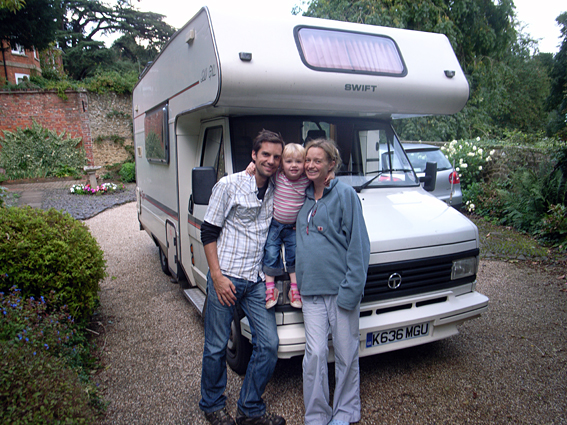
Â
Although it’s not particularly clear, you can get a sense of the ground that we covered in the map below -the ticks mark the places we stayed and/or where I photographed.Â
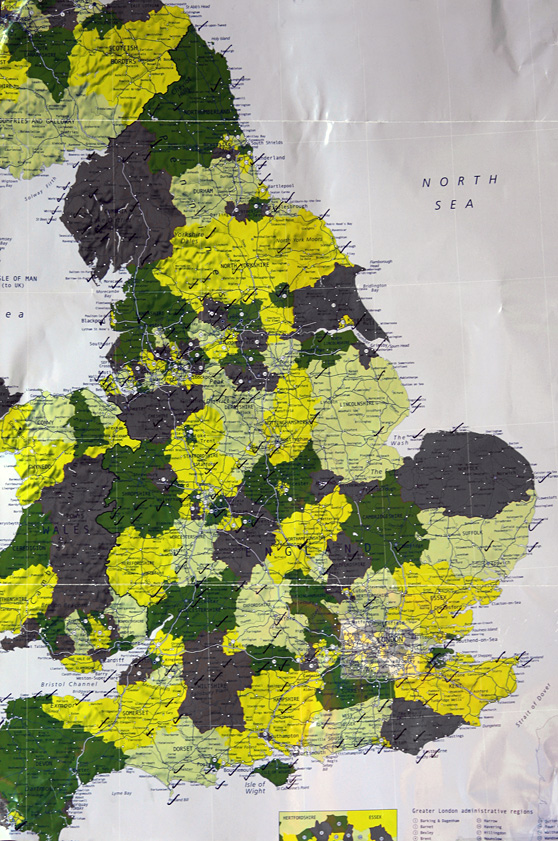
Â
Apologies to anyone from Cornwall, which has somehow managed to get chopped off the map! The only county that we didn’t visit is Buckinghamshire. Fear not, I will make a point of going there in the coming weeks. I’m actually going to continue shooting until the end of 2008, but this will be on a much more targeted basis once I’ve had a chance to edit the material I’ve already shot.
Posted in MISCELLANEOUS, TRIP LOGISTICS | Comments Off on HOME SWEET HOME
September 13th, 2008 admin
We visited Berwick-upon-Tweed last week, a town where L.S.Lowry spent a significant amount of time over the course of four decades. He visited the town many times from the mid-1930’s, often on holiday with his family, until the summer before he died. This gives me a good excuse to post up some of my favourite Lowry paintings, as part of my series on the Art of Leisure.
Laurence Stephen Lowry (born Stretford, 1887; died Glossop, 1976) was the only child of Robert and Elizabeth Lowry. He started drawing at the age of eight and in 1903, he began private painting classes which marked the start of a part-time education in art that was to continue for twenty years. In 1904, aged 16, Lowry left school and secured a job as a clerk in a chartered accountants firm, he remained in full time employment until his retirement at the age of 65. His desire to be considered a serious artist led Lowry to keep his professional and artistic life completely separate and it was not disclosed until after his death that he had worked for most of his life. He initially studied evening classes at The Manchester College of Art under Pierre Adolphe Valette a French impressionist painter one of whose specialities was urban scenes of Manchester. Later he learned the art of portraiture from the American painter William Fitz. It was from these artists that Lowry developed his trademark of stylised figures upon an industrial background.
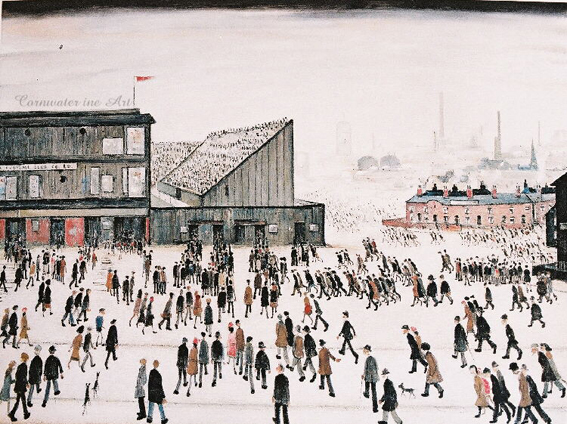
“Going to the Match” 1928, a painting which clearly depicts St. Michael’s Flags and Angel Meadow Park, Manchester.
In 1909, when in his twenties, Lowry moved to Pendlebury, where he spent much of rest of his life and drew inspiration from the mills and factories. In 1916, whilst waiting for a train, Lowry became fascinated by the workers leaving the Acme Spinning Company Mill; the combination of the people and the surroundings were a revelation to him and marked the turning point in his artistic career. Lowry now began to explore the industrial areas of South Lancashire and discovered a wealth of inspiration, remarking ‘My subjects were all around me … in those days there were mills and collieries all around Pendlebury. The people who work there were passing morning and night. All my material was on my doorstep.
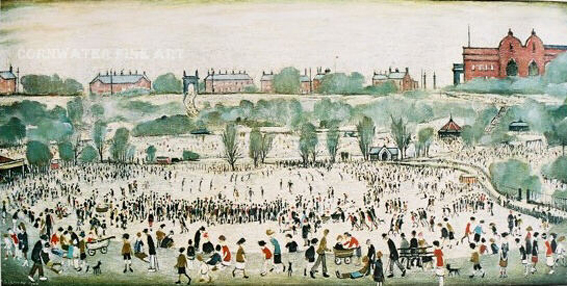
“Peel Park” 1927
Typical of Lowry’s urban landscapes, this is a vivid record of life in industrial northern England. His use of spindly figures, often termed ‘matchstick men’, have become the best-known feature of his work. In early paintings, each ‘matchstick’ figure was carefully and individually depicted. From about 1930, they became less distinctive – anonymous members of the crowd. Although he often depicted industrial cityscapes with some affection, Lowry also conveyed a sense of their bleakness. He invariably used drab colours to portray grimy urban buildings and overcast skies, dominated by ever present smoking factory chimneys.
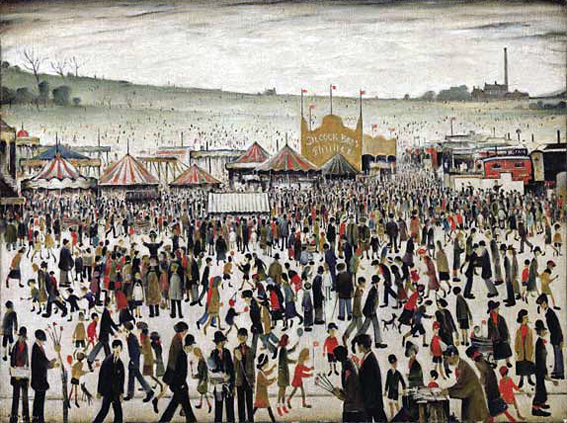
“Good Friday, Daisy Nook” 1946
This painting portrays the Lancashire town of Daisy Nook in festival mood. Traditionally, mill workers were confined to only two statutory days of holiday every year; Good Friday and Christmas Day. Every year on Good Friday, the town of Daisy Nook would stage a fair and provide entertainment to the local crowds. Managed by the Silcock family, whose name appears in the background of the painting, the fair regularly attracted huge numbers of people and still takes place to this day. The present painting depicts this annual fair in 1946, the year after the end of the hostilities of the Second World War. The Ashton Reporter stated at the time that there were ‘Record crowds at Daisy Nook’, as people celebrated a return to the fair and a return to normal life. The painting reflects post-war cheer and relief and depicts crowds of energetic, colourful characters, many holding whirligigs and flags.
On 8th June 2007 Daisy Nook was sold for £3,772,000, the highest price paid for one of his paintings at auction.
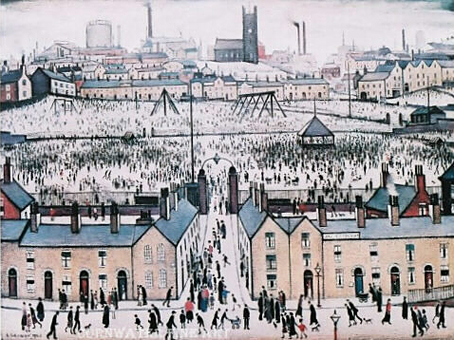
“Britain at Play” 1943
Lowry’s street scenes, peopled with workers, housewives and children set against a backdrop of industrial buildings and terraced houses had become central to his highly personal style. From now on he painted entirely from experience and believed that you should ‘paint the place you know’. Lowry’s leisure time was spent walking the streets of Manchester and Salford making pencil sketches on scraps of paper and the backs of used envelopes recording anything that could be used in his work.
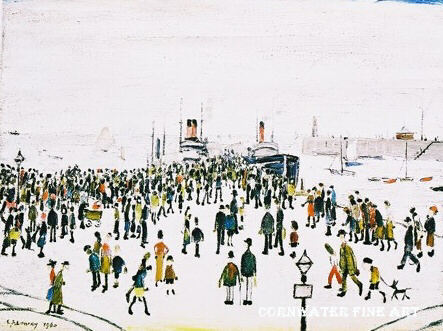
“Ferry Boats” 1960
From his first exhibitions in the 1920s, he built a reputation gradually, only achieving popular success when he was in his sixities, and continued to live a simple and private life. A humble man, Lowry holds the record for turning down the most honours including an OBE. In total he turned down five honour awards and declined the CH in 1972 and 1976.
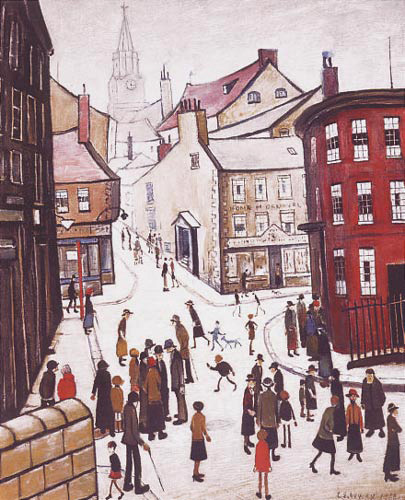
“Berwick Upon Tweed”
To read more about Lowry it’s worth looking at The Lowry Museum’s website here.
There’s an interesting article on the Guardian website by Jonathan Jones written in 2000 when the museum first opened. I’ve quoted a couple of paragraphs from the article here-
“The Lowry paintings worth looking at are the ones everyone knows. There’s no point trying to turn him into a well-rounded artist because he wasn’t one. He was a melancholy compulsive who painted the industrial north of England through deeply disturbed eyes, and caught aspects of it no one else was prepared to look at….Lowry painted the social world of Salford and Pendlebury systematically, illustrating how the factories produced people deprived of identity. His most disturbing images of the working-class crowd depict moments of supposed freedom and leisure: a drawing from 1925 of the bandstand in Peel Park shows people gathering like maggots around a piece of food, while above them the chimneys tower. Again and again he paints the crowd’s attempts at leisure as feeble reproductions of the discipline of the factory. Going to the Match (1953) makes supporting the local football team seem a desperate ritual. One of his scathing images of a crowd trying to forget the factory is called Britain at Play (1943).”
And here’s an article in The Observer by Vanessa Thorpe (March 2007) called ‘Lowry’s dark imagination comes to light’. It explores a much darker, sadder group of Lowry work rarely seen by the public, bleak sketches and paintings that include a series of disturbing and sexually deviant drawings. All had remained hidden until after the artist’s death in 1976. Lowry enthusiast Howard Jacobson argues that ignoring the bleak side of the artist’s imagination has led to him being under-rated and misunderstood by many art critics.
Posted in ART & LEISURE, INSPIRATION | Comments Off on L.S.LOWRY & LEISURE
September 13th, 2008 admin
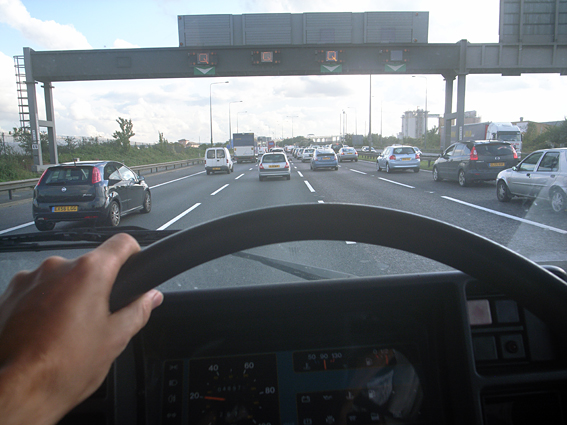
Who on earth came up with the idea that we should spend thousands of pounds of tax payers money putting up signs with the letter Q above our motorways? I can see I’m in queue, I don’t need an illuminated letter telling me that.
Posted in MISCELLANEOUS | Comments Off on Q
September 12th, 2008 admin
We’ve made a slight diversion from the A1 and headed east to north Norfolk to visit Holkham, officially Sarah’s favourite spot in England!
While in the area I took the opportunity to call in on photographer Harry Cory Wright in his Saltwater Gallery. I was interested in meeting Harry as he recently undertook a similar endeavour. In March 2006, Harry took his large-format plate camera, and family, on a trip around the Britis Isles. Beginning in Unst in Shetland at the spring equinox, he travelled down through the Western Isles and mainland Scotland to Northumberland and further south through England and Wales. Merrel have just published the results in the book Journey Through the British Isles.
Â
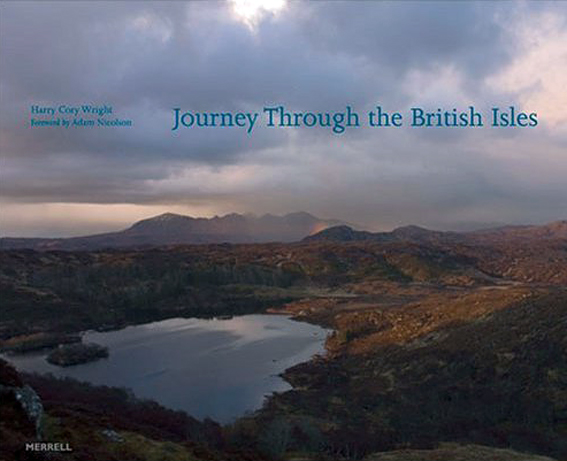
Â
You can read extracts from the blog Harry produced during his journey on The Times website here.
Â
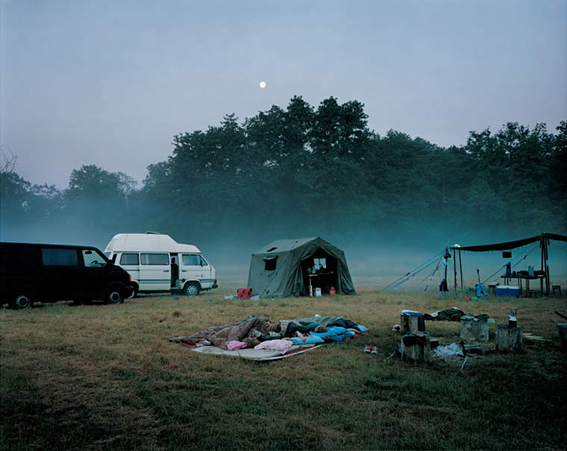
Camp at Tilhill © Harry Cory Wright
Posted in MISCELLANEOUS, RESEARCH | Comments Off on JOURNEY THROUGH THE BRITISH ISLES
September 11th, 2008 admin
As I mentioned in an earlier post, Tom Stoddart is working on a long term project called This England. We’re also joined by photographer Andy Greaves who is working on a documentary about England for his MA course. You can see a few initial images from his project, called ‘England, My England’, on his website here. I look forward to seeing how it progresses.
Posted in MISCELLANEOUS | Comments Off on ENGLAND, MY ENGLAND
September 7th, 2008 admin
We’re heading home!Â
Having made it to the England-Scotland border just north of Berwick-upon-Tweed we’re now going to spend the next seven days driving down the historic A1 to London then on to Brighton. Up until now we’ve made very few journey’s via motorways, preferring to take more minor (and therefore slower) roads, but it seems apt to finish the trip following the route of the Great North Road – which the modern A1 mainly follows.
The Great North Road was a major coaching route in Britain and was used by the mail coaches between London, York and Edinburgh. It is often mentioned in English literature, for example Pickwick Papers by Charles Dickens. The modern course of the A1 diverges somewhat from the Great North Road, particularly where it passed through a town or village that has subsequently been bypassed, or where new motorway standard road has been constructed on a more direct route.Â
The A1 is the longest numbered road in the UK at 409 miles (658km) long and connects the capital of England (London) with the capital of Scotland (Edinburgh). It was once the busiest motorway in the country with an active roadside economy of shops, cafes, hotels. In the 1950s it was supplanted by the newly constructed M1 a speedier and smoother motorway for an England moving slickly into a modernity of effeciency and consumerism.Â
Â
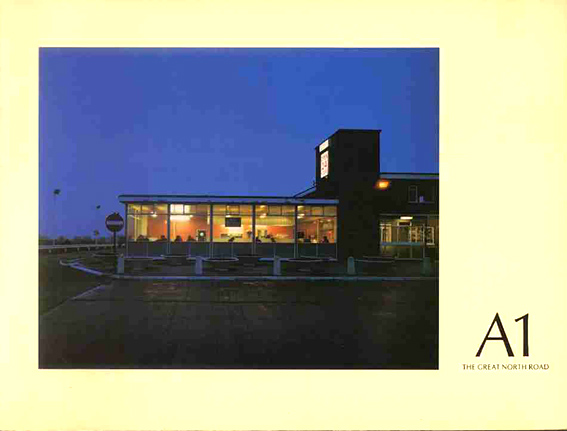
Â
Photographically, the A1 is most readily associated with the work of British photographer Paul Graham. Graham spent two years photographing along the route of the A1 with a large format camera. The work was eventually published in 1983. A1 —The Great North Road was Graham’s first book and contained 41 color reproductions.
Â
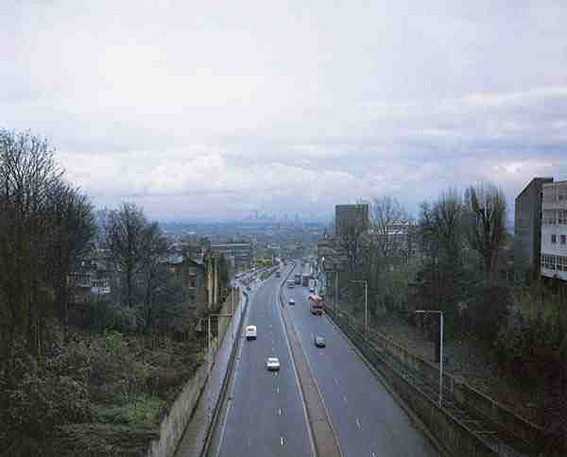
© Paul Graham, 1983
The photographs are a mournful document of a grey nowhere land in a country moving too fast to stop for a cup of tea. The book is now a valuable collectors item, valued at over £250, not bad for a self-published paper back! I’ve posted up a couple of the pictures from the book here, but you can see more on Graham’s website.
Â
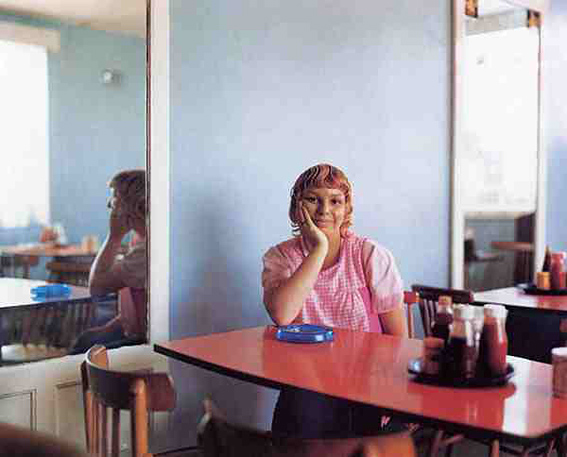
© Paul Graham, 1983
According to many commentators, Graham’s A1 photographs had a transformative effect on the black and white tradition that had dominated British art photography till that point. This work, along with Graham’s later photographs of the 1980s – the colour images of unemployment offices in Beyond Caring (1984-85), and the sectarian marked landscape of Northern Ireland Troubled Land (1984-86) – were pivotal in reinvigorating and expanding this area of photography, by both broadening it’s visual language, and questioning our notions of what such photography could say, be, or look like.   Photographers like Martin Parr made the switch to colour soon after, and a new school of British Photography evolved with the subsequent colour work of Richard Billingham, Tom Wood, Paul Seawright, Anna Fox, among others.
Â
Posted in INSPIRATION, PLACES, TRIP LOGISTICS | 5 Comments »
September 6th, 2008 admin
Now that my journey across England is nearing an end, I wanted to look at the notion of the road trip in photography. While I’ve already touched on the timeline of British photographers who have used the road trip as a vehicle for documenting England/Britain, I want to now turn my attention to the work of American photographers. I’ll do this over several blog entries (I will look at European photographers in a future post).
Highway culture has long been a quintessential part of American identity and is also reflected in the canon of contemporary American photography who have worked within the tradition of the road trip across America. Names such as Jeff Brouws, Tim Davis, William Eggleston, Mitch Epstein, Robert Frank, Lee Friedlander, Todd Hido, Dorothea Lange, Ed Ruscha, Lise Sarfati, Stephen Shore, Rosalind Solomon, Alec Soth, Mark Steinmetz, Joel Sternfeld, and Garry Winogrand and others, have all embraced the genre. Several of whom have been major influences in my own work (particularly in Motherland), notably the work of Stephen Shore and Joel Sternfeld.
By way of an introduction to the genres I’m posting up details of an exhibition that was held at the Yancey Richardson Gallery last summer called Easy Rider: Road Trips Through America, which focussed on the road trip in American photography.
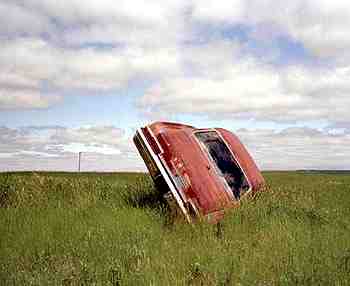
Jeff Brouws, Route 248, Four Buttes, Montana, 2004
The following text is taken from the Easy Rider exhibition press release-
“Easy Rider explores the common themes of social commentary, cultural geography and photographic biography produced by the marriage between the road and photography. Included are photographs and videos dating from 1935 to 2006.
The road allowed Farm Security Administration photographers Dorothea Lange and Walker Evans to document the plight of Americans suffering floods and dustbowls during the Great Depression. Similarly bleak, Robert Frank’s mid 1950s road trips yielded a portrait of the nation at odds with the projected optimism of the era and culminated in The Americans, a landmark publication, which influenced generations of later photographers.
The open road as a symbol of freedom is exemplified in Allen Ginsberg’s 1964 shot of Neal Cassady at the wheel of Ken Kesey’s Merry Prankster bus; Cassady’s incessant cross-country journeys were a primary inspiration for Jack Kerouac’s definitive Beat generation novel On the Road. Having spent four years riding with the motorcycle gang the Outlaws, Danny Lyons produced the book The Bikeriders, which emblazoned motorcycle counterculture onto the American psyche and inspired the film Easy Rider.
Subsequent generations of photographers continued to take to the road in order to explore the cultural landscape. Traveling on a 1969 Guggenheim to study the effect of the media on public events, Garry Winogrand recorded America’s restlessness through its political rallies, peace demonstrations and space shuttle launches. In the 1970s Mitch Epstein looked at recreation across America while Joel Sternfeld’s wryly-funny photographs often showed man at odds with nature. Alec Soth followed the watery artery of the Mississippi River to make pictures of the dreams; both lost and fiercely held, of those he encountered. More recently, Tim Davis traveled the country to seek out the presence of politics in today’s life; in St. Louis he found a wall mural of the United States depicted as one grotesquely stretched red state.
Several photographers have looked closely at the details and detritus of American culture for clues to its soul. William Eggleston’s photograph of an elegantly wallpapered restaurant wall plastered over with the business cards of its patrons shows commercial aspirations trumping style. On the bare chipboard walls of Reverend and Margaret’s Bedroom, Soth memorializes a moving display of family photographs while Lisa Kereszi’s discovery of a biker bar’s photographic collage of women flashing their breasts reveals the misogynist underbelly of road-worshipping motorcycle culture.
Many photographers have constructed a kind of biography of roads traveled, places visited and people encountered, often including themselves and family m embers. In 1962, Ed Ruscha photographed isolated gas stations along Route 66 filling half the picture frame with the street at his feet. Lee Friedlander frequently incorporated himself into his car images, staring into the camera through the windshield or via the side view mirror. In his witty series America and Me, recent Bard graduate William Lamson photographed himself interacting with elements of the roadside landscape, always hiding his face but freely revealing the shutter release. Poolside at a roadside inn, Stephen Shore incorporated his young wife Ginger into a minimalist composition of color and light. Accustomed to working on the road, Justine Kurland adjusted to motherhood by photographing her young son living with her in a camper van on an extended road trip.
Jeff Brouws has made a career of photographing along highways, evolving from cataloguing the relics of small town roadside architecture to documenting the negative impact of thruways in the 21st century. His 2004 image of a rusting red car upended in a field presents a pessimistic view of contemporary road culture: the car as a dinosaur on the road to nowhere.”
My subsequent posts will look at the work of individual photographers.
Posted in EASY RIDER, INSPIRATION | Comments Off on EASY RIDER – TRAVELS THROUGH AMERICAN PHOTOGRAPHY PART 1
September 6th, 2008 admin
We took a brief diversion this weekend to attend my cousin’s wedding in Edinburgh. Driving north on the A1 from Berwick it was intriguing to see the different ways that England and Scotland mark their border posts. As you head north drivers are met with a large, clear sign based on the Scottish flag, which welcomes you to Scotland. It could be seen from a distance, even in the pouring rain.Â
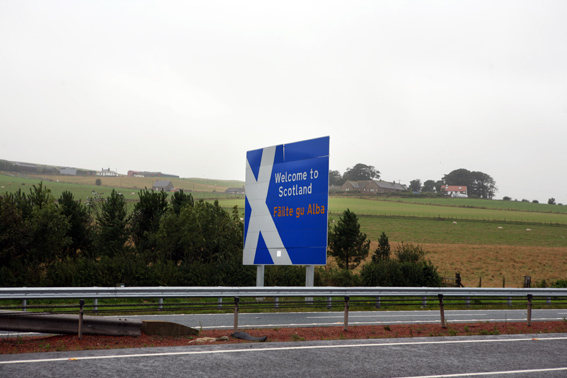
Â
Driving south a couple of days later, in similarly depressing weather conditions, I only just spotted our border post. A rather pathetic stone block, covered in lichen, with the barely readable words ‘England’. Â
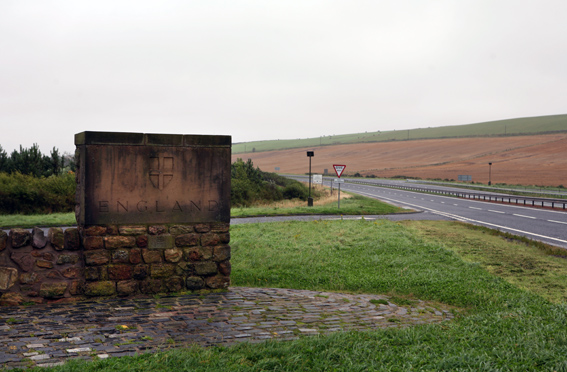
Â
Are there conclusions to be drawn from these contrasting declarations of identity?!
Â
Posted in MISCELLANEOUS | 1 Comment »
September 4th, 2008 admin
Spent the day in the Northumberland coastal town of Seahouses….
Â
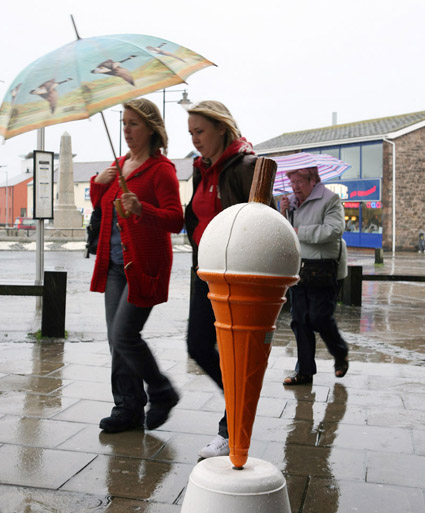
Â
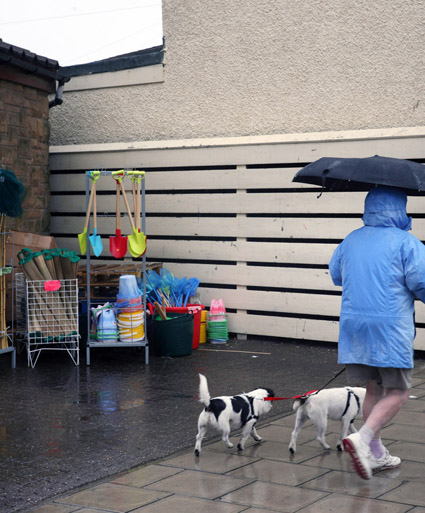
Posted in POSTCARDS | Comments Off on SUMMER IN SEAHOUSES
September 4th, 2008 admin
After an unsettled night free-camping in Carlisle’s Rickerby Park, where we inadvertently found ourselves parked near a road favoured by the cities boy-racers (it was 11.30pm and too late to move!), we’re now driving through the county of Northumberland.Â
Once part of the Roman Empire and the scene of many wars between England and Scotland, Northumberland has a long and violent history. The bloodiest battle currently taking place in the county (well in Tyne & Weir which was historically part of Northumberland) appears to be at Newcastle United FC where the club’s fans have declared war on Mike Ashley, Newscatle’s owner, over the forced departure of coach Kevin Keegan. Such is the passion that football stirs amongst Tyneside fans.
We’ll be spending the remainder of the week in the county driving along Hadrian’s Wall, stopping off at Kielder Water (the largest man-made lake in Western Europe) then heading north up the coast to our final destination of Berwick-upon-Tweed near the border with Scotland.
Â
Posted in PLACES, TRIP LOGISTICS | Comments Off on BOY RACERS & BLOODY BATTLES




















